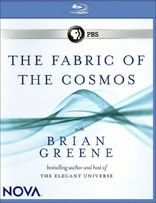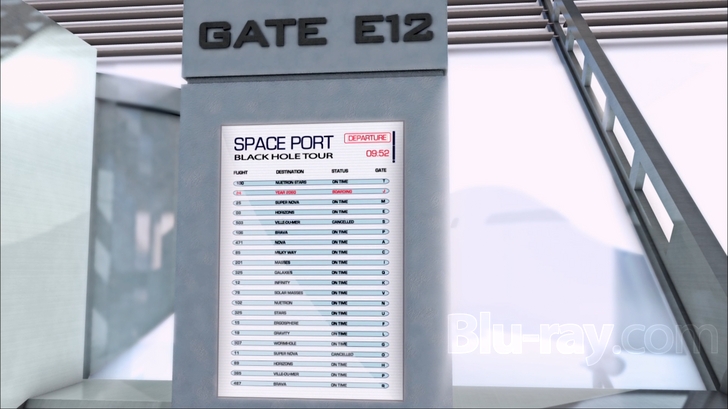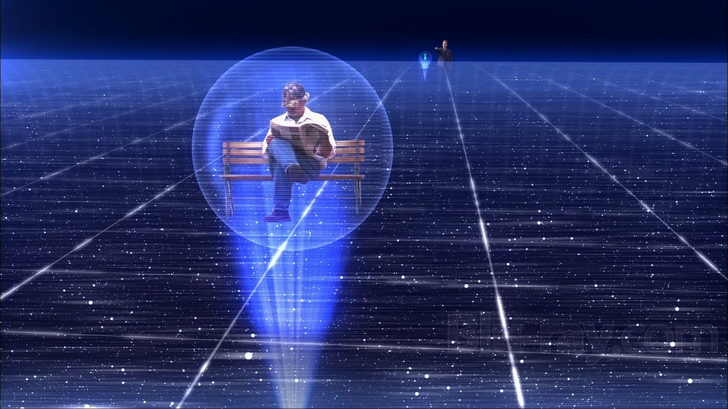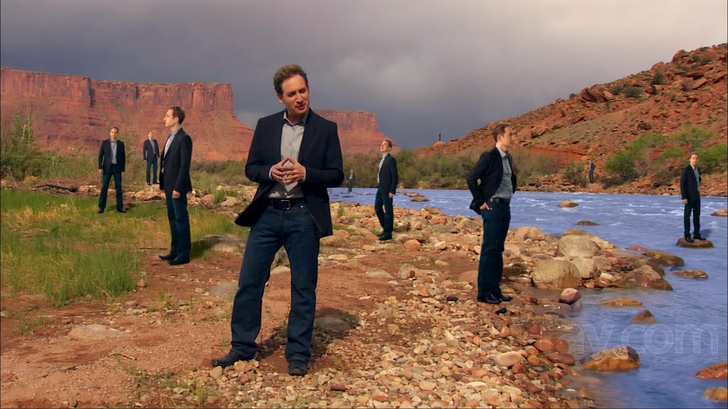NOVA: The Fabric of the Cosmos Blu-ray Movie
HomeNOVA: The Fabric of the Cosmos Blu-ray Movie 
PBS | 2011 | 223 min | Not rated | Nov 22, 2011
Movie rating
6.9 | / 10 |
Blu-ray rating
| Users | 0.0 | |
| Reviewer | 3.0 | |
| Overall | 3.0 |
Overview
NOVA: The Fabric of the Cosmos (2011)
The Fabric of the Cosmos, based on the book by physicist and author Brian Greene, takes us to the frontiers of physics to see how scientists are piecing together the most complete picture yet of space, time and the universe. With each step, audiences will discover that just beneath the surface of our everyday experience lies a world we'd hardly recognize, a startling world far stranger and more wondrous than anyone expected.
Starring: Brian Greene (V)| Documentary | 100% |
Specifications
Video
Video codec: MPEG-4 AVC
Video resolution: 1080i
Aspect ratio: 1.78:1
Original aspect ratio: 1.78:1
Audio
English: DTS-HD Master Audio 2.0
Subtitles
English SDH
Discs
25GB Blu-ray Disc
Two-disc set (2 BDs)
Playback
Region A, B (C untested)
Review
Rating summary
| Movie | 3.0 | |
| Video | 3.0 | |
| Audio | 3.0 | |
| Extras | 0.0 | |
| Overall | 3.0 |
NOVA: The Fabric of the Cosmos Blu-ray Movie Review
A brain-bending series with a rainbow twist
Reviewed by Brian Orndorf December 17, 2011Who needs drugs when physicists are around?
Buckle up your brain and strap yourself down, because Brian Greene is here to explain the mysteries of the universe. The author of the 2004 book, “The Fabric of the Cosmos: Space, Time, and the Texture of Reality,” Greene is an educator on mission to clarify the great unknown to the masses. Literary pursuits and college lectures only get a man so far, leaving the clenched fist of PBS the only way to reach out and awaken viewers. “The Fabric of the Cosmos” is a four-part documentary on specific findings in the scientific community, exploring galactic particulars with the assistance of extensive greenscreen work and CGI ornamentation, helping to breakdown supremely complex theories and questions in the land of physics. There’s no better way to bring the heaviness of the universe to television than with a sound and light show starring a chipper professor eager to share his remarkable knowledge with the world.
“The Fabric of the Cosmos” stares down some rather impenetrable ideas about space and time, forcing the production to package the concepts with a certain speed and visual zest, employing interviews with top minds to strengthen the debate. The program is no lecture, with Greene droning on about physics while a PowerPoint presentation clicks away. The show is more energetic, bouncing around the frame to capture the excitement of the stars, coming straight at the viewer to make things like string theory and quantum mechanics semi-fun and educational. However, Greene is careful not to dumb the material down, keeping information accessible but accurate, risking the loss of those who truly cannot keep up with such an in-depth discussion of matters that are rarely discussed. “The Fabric of the Cosmos” lost me on several tangents into the great unknown, but the miracle of the show is its tenacity, always attempting to lure interest back through bright visuals and constant earthbound examples, with Greene a most animated host. The program doesn’t give up, it wants outsiders to connect with the ideas on display, while also retaining the physics crowd used to exhaustive analysis and spirited conversation.

EPISODES
“What is Space?” (55:48, Airdate – 11/2/11) introduces viewers to Brian Greene, a professor at Columbia University and a man determined to bring the universe to PBS homes everywhere. Hour one concerns the very nature of space, once thought to be a lifeless component of the galaxy. Through research conducted by Isaac Newton, space was actually discovered to be a critical element of the universe, thought to resemble a fabric that interacts with its surroundings, filling a more critical role in the understanding of the world than the emptiness it was previously thought to be. We rapidly move over to theories put forth by Albert Einstein, shaping the perception of space further, developing a deeper appreciation for the movement of the galaxy, with its endless expansion and contraction. We witness the launch of a critical scientific space experience, where enormous gyroscopes were put to use (after decades of planning) to gauge how space bends, furthering the fabric idea. The wily world of particles are explored, observing their nuances and secrets, heading over to the CERN facility and the Large Hadron Collider in Geneva, where scientists are currently looking to crack the particle code, using work from physicist Peter Higgs, whose radical concepts about space helped to expand awareness of the subject. Finally, the program takes a look at the mystery of “dark energy,” an unknown element of space currently being investigated by scientists.
“The Illusion of Time” (55:47, Airdate – 11/9/11) follows Greene as he inspects the deceptive nature of time and the numerous ways we interpret a scientific measurement that’s only marginally understood. He travels to the National Institute of Standards and Technology in Colorado to view the most accurate clock on Earth, which uses the atom of cesium to track the seconds, minutes, and hours. Greene steps back in time to the birth of train travel, which required a specific concept of time zones to help sort through the chaos. Einstein returns to the program as Greene chats up “spacetime” and “now slices,” exploring the perception of time and how it differs for everyone -- a scientific pursuit Einstein pioneered, building upon Newton’s work. Lastly, the episode spotlights the “arrow of time,” a concept that opens up a larger dissection of time travel (to both the future and the past) and the particulars of black holes and worm holes, both potentially open to humans as a method of visiting corners of time previously explored only in science fiction entertainment.
“Quantum Leap” (54:56, Airdate – 11/16/11) follows Greene into the mysterious elements of quantum mechanics, a puzzling development in the cosmos that’s come to electrify curiosity among physicists. History is established with classical mechanics, which soon gave way to quantum mechanics when scientists investigated further. Niels Bohr is generally credited as the man behind the notion of a quantum leap, and his story is recounted here. Greene goes on to examine the double slit experiment, while discussing Max Born and his wave equation. The show moves on to John Clauser, a physicist brave enough to pick up the work left behind by Einstein, who fought the basics of quantum mechanics, preferring a knowledge of purpose over an understanding of chaos. Talk soon turns to teleporting, considering the “beam me up” routine from “Star Trek,” which isn’t entirely out of the question in terms of travel, using the complexity of quantum entanglement to “energize” subjects anywhere they want to go. And quantum bits (or qubits) are explored, highlighting the potential for computer technology that’s far beyond what we all use today. Imagine a world where computers are able to solve complicated problems in seconds. The future can’t come fast enough.
“Universe of Multiverse?” (55:46, Airdate – 11/23/11) opens by taking the viewer to the edges of the universe, where physicists are hunting for the next great discovery, digging around the beyond to find evidence of the “multiverse” -- additional areas of space expansion that could possibly mirror our own galaxy. Moving over to the work of MIT’s Alan Guth, the program digs into the expansion of the universe, also spotlighting Alex Vilenkin and his quest to prove the concept of eternal inflation. There’s a return to the mysterious qualities of dark energy, which provides something a clue toward the discovery of the multiverse. The show quickly plows into the core of an atom, unearthing the world of string theory and the fascination with mutilverse discoveries, with Greene openly questioning how the inhabitants of another Earth would deal with differences in evolution. The distances are unthinkable, but scientists seem eager to crack the multiverse code.
NOVA: The Fabric of the Cosmos Blu-ray Movie, Video Quality 

As visually fidgety a PBS program as I've ever seen, "The Fabric of the Cosmos" comes to Blu-ray boasting an AVC encoded image (1.78:1 aspect ratio) presentation. Edits and special effects fly fast and furious here, with a specific push of color to help the viewer connect with this highly intellectual pursuit. The bright palette is a necessary tool to help the entertainment factor of an otherwise impenetrable series, with excellent blues and reds representing bursts of particles, while grander golds and deep blacks provide a rich feel for galaxies and the darkness of space. Heavy with graphics, the program makes smart use of color, and the disc offers hue stability throughout. Interview footage is pulled from a variety of film and video sources, abandoning a singular quality, but the image is clean, providing a crisp view of Greene's ringleader role, with a fresh feel for greenscreen activities hampered by steady banding and some haloing on planetary graphics. Skintones are natural, while shadow detail is quite good, providing a clear look at the myriad of details, charts, and visual effects that fill the frame, supplying texture to the image without softening the fine details.
NOVA: The Fabric of the Cosmos Blu-ray Movie, Audio Quality 

The 2.0 DTS-HD MA sound mix is relatively peaceful for such a hyper program, attacking the necessity of explanation with a crisply defined frontal push of interview audio and Greene's narration. Voices are clear and expressive, with a welcome sense of accents and educational concentration. Scoring is subdued, kept at a distance from the on-screen event, never quite making a perceptible impression. Visual effects are pronounced, with the sounds of the cosmos swirling around the screen, bringing movement to science and theory, sustaining the busy atmosphere of the series without smothering the conversations. Low-end is sparse, only making a minor impression with big bang events. Admittedly, the show runs rather loud at a normal volume setting, perhaps trying to keep attention toward the screen when the subject matter trails off into obscure areas of physics.
NOVA: The Fabric of the Cosmos Blu-ray Movie, Special Features and Extras 

There is no supplementary material included.
NOVA: The Fabric of the Cosmos Blu-ray Movie, Overall Score and Recommendation 

"The Fabric of the Cosmos" isn't for every taste, but it retains an integrity that's admirable, while pushing forward with a manic visual scheme that's helpful when dealing with colossal scientific concepts. It's an amusing program at times, willing to hunch down and include the larger audience, but at the core of Greene's work is a dedication to a feeling of wonder, looking out at the world with a giddy curiosity that's shared by the interviewed physicists. The series doesn't always make sense to the layman, yet it's easy enough to get swept up in the rush of information, to get excited about the possibility of the universe and its countless secrets.
Similar titles
Similar titles you might also like

Cosmos: A Spacetime Odyssey
2014

Magic of Flight
IMAX
1996

Rocky Mountain Express 4K
IMAX
2011

Stephen Fry in America
2007

How the Universe Works
2010

Microcosmos
1996

Humpback Whales 4K + 3D
IMAX
2015

Flight of the Butterflies 4K + 3D
IMAX
2012

Galápagos 3D
IMAX
1999

Helvetica
2007

In Search of the Last Action Heroes
2019

Pandas 4K
2018

Space Junk 3D
IMAX
2013

Food, Inc.
2008

A Place at the Table
2012

Spitfire: The Plane That Saved the World
2018

Arabia 3D
IMAX
2010

Legends of Flight 3D
IMAX
2010

Dinosaur 13
Director's Cut
2014

Rescue 3D
IMAX
2011